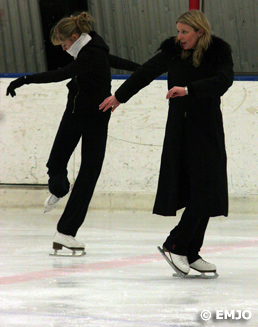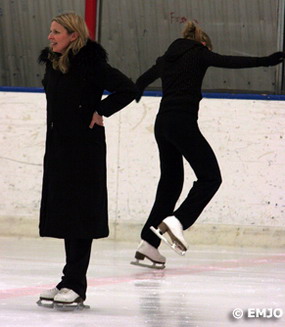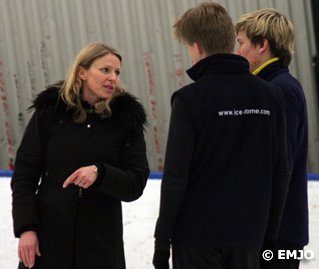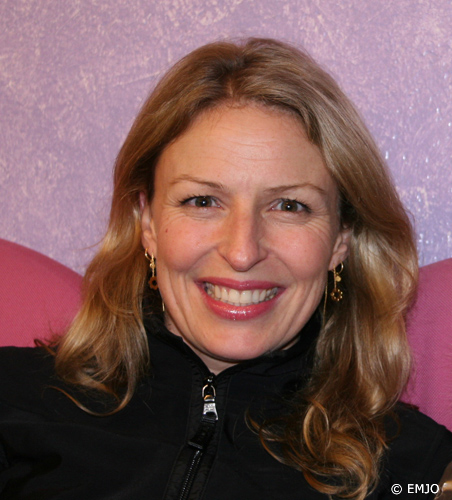Lori Nichol – more than meets the eye
ÂBy Magdalena Osborne
Photos © EMJO
To the average person the name Lori Nichol may not mean a lot. That person would see an extraordinary woman empowered with more energy in a single day than most people hope to get in a lifetime. Her bright smile and bubbly personality would also be noted and none of that is in any way bad. But to the people involved with figure skating this woman is so much more, she is the Lori Nichol!
That spells nothing short of being a much sought after Canadian top choreographer whose merit list includes working with Michelle Kwan, Jamie Salé & David Pelletier, Timothy Goebel, Takeshi Honda, Brian Boitano, Brian Orser, Kurt Browning, Tara Lipinski, Josee Chouinard, Jennifer Robinson, Tatiana Totmianina & Maxim Marinin … the list is almost endless. And many eligible skaters competed this past season with programs designed by Lori, such as Jessica Dube & Bryce Davison, Fumie Suguri, Patrick Chan, Chris Mabee, Xue Shen & Hongbo Zhao, Kimmie Meissner, Evan Lysacek, Mao Asada, Carolina Kostner... Some of them did very well in Tokyo because of it!
Although many skaters travel to Canada to see her, Lori travels too. She came to Sweden just before the World Championships to work with Carolina Kostner. We watched them train together, you can read the full report here.

© Caroline Paré |
It all started two years ago when Carolina went to Toronto to meet with Kurt Browning. He asked Lori for help with Carolina’s “Four seasons” program, and this past season Carolina’s short and long programs were both products of Lori. But there wasn’t much time to put them together. I was only in Oberstdorf for five days so we worked long hours everyday, but Carolina was just fantastic through all of it. We were just joking we’ve almost worked even harder here than in the initial time. I really respect that she kept the initial choreography and worked so hard to make it work, it’s very rare. I haven’t seen her since we made the programs and I’m very pleased with what she’s done with them. |
Those programs and the way Carolina skated earned her gold at the 2007 European Championships in Warsaw. A few small changes were made before Worlds, mainly to the arm movements.
In spite of having so many skaters competing in Tokyo, Lori remained at home. During competitions she spends time with her children and doesn’t even watch that much skating on TV. But that’s her own choice, it’s not because she gets too nervous.
Oh no, I can stay calm! I actually had to go to a competition (Campbell’s) with Evan Lysacek because Frank (Carroll) couldn’t go, and Evan said “You’re so calm!”
Well, once you’ve delivered two children and you live a hectic daily life and you’ve been to a few Worlds and Olympics, then you start to come to terms with what it’s all about. It’s about being calm so the skaters can feed off the good vibes.
Coaches, take heed.
Many probably wonder how a top choreographer like Lori works, raising questions like who chooses the music?
In 99.9 percent of the time I choose the music. When the skaters come to Toronto we listen in a studio, and I may be down to either this music or that music. Sometimes I don’t know the skaters well enough yet and I need their opinion and to hear their reactions to different pieces of music. I’ll take a collection of different pieces on the ice with us the next day and I’ll play creative movement. Then I’ll watch how their bodies move and what they enjoy doing, but most of all what looks the best for them. And then we begin the choreography.
So that’s the usual process, but with Carolina it was different.
Yes, she knew exactly what she wanted to skate to! It was the first time I went somewhere and the music was already picked. For me it was a very new experience and a whole lot less stress!


She laughs about it, but the music is not always a laughing matter. What if she and the student have totally different opinions on what music is suitable!
And that happens all the time! Really, all the time! Sometimes I’m too lenient, the skaters have to love skating since they’re the ones at it every day so they must enjoy the music. But on the other hand there have been times when I wish I had just said “no, this doesn’t work”. You just hope it doesn’t happen during an Olympic year cause then I will put my foot down for sure.
Choreographing is an art and art requires inspiration. But while some choreographers gain inspiration by watching other skaters, Lori looks elsewhere.
I actually don’t watch a lot of skating… I watch modern dance on stage and modern ballet. I study dance and I like to go to museums and get inspiration from a lot of different places (Lori choreographed Kwan’s “Taj Mahal” program). But I don’t spend a lot of time watching skating, I’ve never done that. I want to have fresh ideas.
And fresh ideas are needed, especially when she gets contacted by skaters she doesn’t know. They send her a DVD with them skating to many different music styles, but that’s just the beginning. On ice she wants to see how they move and how open and adaptable they are, as well as what kind of versatility they have with steps and movements. All that will help her decide what will be the best for them to skate to and at what level. The levels and special rules of the Code of Points have to be ever present in the mind of a choreographer. There are many things to keep track of, but it must also work for the skater.
I see great pros and great cons with the system. I find it’s not about the art of skating and it’s not about being artistic; it’s about being clever. And in a way clever employs artistic vision but it’s not the same freedom. But I also didn’t enjoy the Olympics in Salt Lake City under the old 6.0 system, what happened there was very bad for the sport.
Most people didn’t enjoy the pairs controversy, except maybe the press. To Lori it was traumatic since she had choreographed Jamie’s and David’s “Love story” free program. A new system was certainly welcome.
 |
The good thing is that skaters from around the world now know what is expected of them and for a beginning coach and choreographer it’s much easier to come up with ideas. And we’re getting a better average program. Another good thing she appreciates about the system is that a fall and other mistake no longer mean the end. Being fourth or worse after the short program hasn’t eliminated the chances of winning, although some skaters still act like it. |
If you go to the ballet or modern dance or a play and someone missed a line, they wouldn’t sulk or get all upset, they would work even harder to prove their ability as an actor or a dancer. The skaters need to take on that mentality, but many of them are like, "well, I missed a second or third thing, buhu!". But the performance still matters and I think it's a good thing about the new system that the skaters know they will be rewarded for continuing, in the program components, in between the jumps, so it's still worth it to continue. Before they knew that after two missed jumps you might as well forget it, so I think that’s where that mind set came from. The new system will help that a great deal.
Mao Asada knows it. After a disappointing performance in the short program in Tokyo she was only in fifth place. But she wasn’t about to give up! Giving it her all she delivered when it counted and comfortably won the freeskate. Overall she finishing less than a point behind Miki Ando and won silver. In such cases the system is working right!
But it’s not all peaches and cream, and at times Lori finds the C o P rules downright frustrating.
I’d say that from the middle level and on up it’s much more stagnating. As a choreographer I sometimes really feel like I’m wearing a straight jacket, every time I seem to come up with a really great idea it’s illegal.
And my guess is that she’s in good company. Many coaches and choreographers seem to agree that the C o P is a step up from the old system, but that many flaws still need to be fixed. Lori feels the spins are among those flaws.
I keep asking why 3 spins isn’t enough! I mean, if you can’t tell after 45 seconds of spinning if the skater is good at it or not, them we have a serious problem. And I’m not a fan of many of the spin positions, I think many of them are ugly and don’t have anything to do with the music. Each spin is also in such extreme positions that I’m very concerned about the health of the skaters. The backs with the girls and Biellmanns, and the hips with both the girls and the boys. I’m concerned about the 2010 Olympics in Vancouver and what bodies we will have left. So that spin rule really bothers me...
With so many skaters getting injured each season, her worry is legitimate. And for many skaters the rules have changed. They started skating under the old 6.0 or interim system and now have to join the static hunt for points. Lori feels a bit more flexibility wouldn’t hurt. It could start with the music. You’re very limited in your selection of music. You can’t use vocals and in the short program you need to use a slow and a fast or all slow cause you have to do the spiral sequence to slow music, it looks ridiculous to fast music. |
 |
I also feel the women should have a choice in the long program between a second step sequence and a spiral sequence. Now most would choose the spirals anyway because it’s much easier to get a level 4 spiral sequence than a level 4 step sequence. But I also think the guys should have that choice. In order for the artistic impressions in programs not to all look the same, that choice needs to open up. And I don’t think it’s right to have the layback being a requirement for the girls. I just don’t think the Biellmann proves a darn thing! I mean, I go to rinks all over the world and everywhere I go I see better Biellmanns on 7-9 year old girls. They can’t do a decent waltz jump, but they can certainly do that spin! I’ve also seen it in ballet studios and gymnastic clubs, so it doesn’t prove your value as a skater at all.
Overrated in other words. And if the Biellmann is a less attractive move for the ladies… But the discussion on what it does for the men was left out. Focus instead shifted to what should be emphasized.
|
To me, I’d like more emphasis on what makes skating skating, and make that valued more. By simply taking out that fourth spin there would be approximately 15 more seconds of movements and edges and time to really develop depth of edge. Now we don’t have that time, it’s so rushed. I feel like constant limitations, but on the other hand I love how people now pay much more attention to steps and to full body movement. |
True, although some skaters feel they don’t get paid for those things in the program components, and that the judges tend to give a skater very similar marks in all five categories.
I do think there are several good judges that do understand the program components. It’ll be a while before we get the majority of them on the panel, but that’s life. But I feel that some skaters are getting what they deserve and that’s very important. I still teach the judges every year which I love to do. It’s very important to me to further their education and motivating them to educate themselves as well. And I am noticing more and more are getting much higher in quality and more serious about spreading the marks.
There should be hope then, and Lori really feels for the judges. They have rules to follow too and are under a lot of pressure; just like the skaters, but theirs is a different kind of pressure. She likes lecturing to them since they are such good listeners.
They really love the sport, obviously to be volunteering and giving so much of their time to it, and they are much kinder and less critical in regards to what the skaters do. The skaters themselves are much harsher than any judge ever could be! I feel that most judges have good intentions but maybe education is the key.
Education along with a greater understanding between the various parties involved with the sport.

I probably choreograph 6 hours a day 300 days a year and that’s going to come from a different perspective than a skater who’s with the choreographer 3 weeks a year, and that’s going to be from a different perspective than the coach who never deals with the choreography, to the coach who works every single day on choreography with the skater.
And that’s also a very different perspective than the judge who judges 3 weeks of the year and has a full time job and a family and is very busy, which makes it difficult to study that much more. So it’s different how much they all can observe and take in, and the bottom line is that we all have incredibly different perspectives and incredibly different levels of knowledge. I’d like to raise that level of all the people involved in the sport. And then I think we’ll see that the Code of Points have many good things to it and hopefully over time the things that aren’t working will be changed. I’m trying to take care of it from my end which is the ice.
And by publishing this article the AS team is trying to do its part as well. The new system isn’t perfected yet and the powers that be in skating would do well to listen to Lori and others who have constructive ideas for improvements.
The 2006/2007 season is pretty much over, and in rinks all around the world the work to create programs for next season has begun. We wish Lori and all other choreographers good luck with their work; we can’t wait to see what you come up with!




